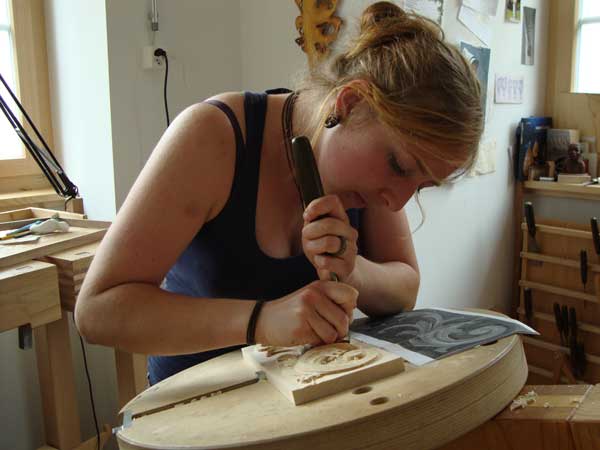
Brienz, Switzerland, is the heart of the country’s woodcarving region – and the home of the only Swiss woodcarving school. Founded 131 years ago, in 1884, the Brienz School for Woodcarving (Schule für Holzbildhauerei Brienz) has roughly 30 students at a time, divided fairly evenly among men and women. The youngest students, called apprentices, are 15 or 16 years old, while the oldest, at the moment, are around 35. Students are selected for the four-year program via a three-day entrance exam, which does include carving on a piece of modeling clay as a test, but, says René Reusser, the school’s woodshop instructor, it’s the students’ drawing skills that really get them in. “Pretty much every kid has access to a pencil and paper,” he said, but “not every kid has a granddad with a shop and carving chisels when are nine years old.” 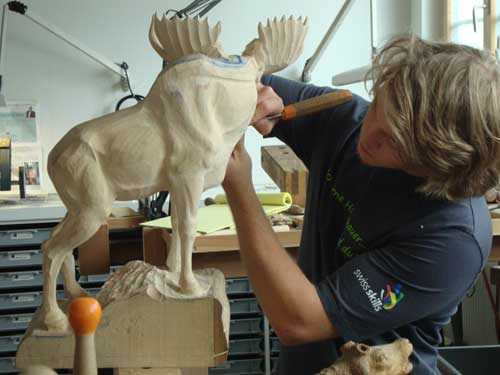 The younger students have likely come just out of their nine years of primary school, while older ones may have already done an apprenticeship in a different trade – furniture making, for example. René, who spent some time in Canada, said, “I noticed that in America, you almost have to go to college, because ‘that’s what you do.’ In Switzerland, you can say, ‘I’m a furniture maker,’ or ‘I’m a timber framer,’ and there’s no difference in respect. In Switzerland and Europe, craftsmanship is appreciated.” Salaries for manual labor, René said, reflect that respect.
The younger students have likely come just out of their nine years of primary school, while older ones may have already done an apprenticeship in a different trade – furniture making, for example. René, who spent some time in Canada, said, “I noticed that in America, you almost have to go to college, because ‘that’s what you do.’ In Switzerland, you can say, ‘I’m a furniture maker,’ or ‘I’m a timber framer,’ and there’s no difference in respect. In Switzerland and Europe, craftsmanship is appreciated.” Salaries for manual labor, René said, reflect that respect. 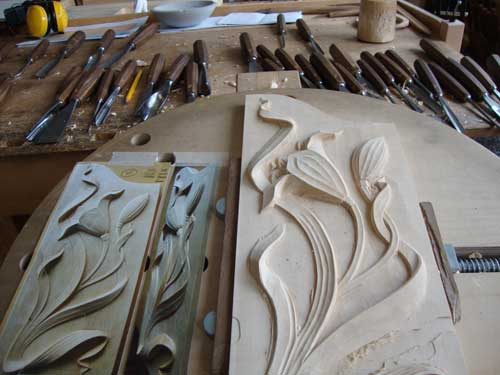 At the woodcarving school, the students learn from five full-time master carvers, most of whom have been on staff for several years. Each has a different specialty, often depending on the area of the country where they have lived. “If you live in a Catholic part of the country, you got to carve more religious things; in other areas, it’s more naturalistic, where hunting is a big thing,” René said. René himself has a background in furniture and guitar making; he works one or two days a week at his own shop making guitars, and the rest of the week at the school in the woodshop. He teaches all of the students, “because it’s a small part of their work,” but “they have to be able to do cabinetry; planer, jointer, all of that.”
At the woodcarving school, the students learn from five full-time master carvers, most of whom have been on staff for several years. Each has a different specialty, often depending on the area of the country where they have lived. “If you live in a Catholic part of the country, you got to carve more religious things; in other areas, it’s more naturalistic, where hunting is a big thing,” René said. René himself has a background in furniture and guitar making; he works one or two days a week at his own shop making guitars, and the rest of the week at the school in the woodshop. He teaches all of the students, “because it’s a small part of their work,” but “they have to be able to do cabinetry; planer, jointer, all of that.”
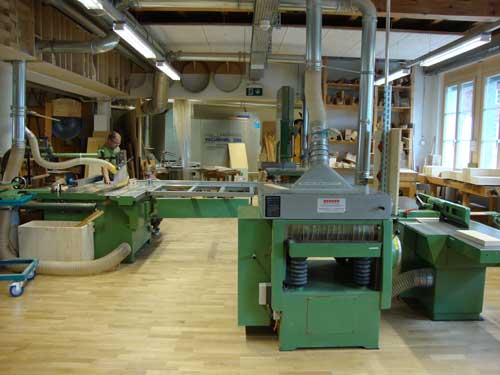
Sometimes other specialists, such as coopers, basket makers or woodturners will visit the school and “widen the horizons of all the people that are here,” or offer opportunities for collaboration. Otherwise, René said, the school teaches “only woodcarving, and the furniture that goes with it.” The system is set up mostly as hands-on time, with students in the workshop for six to eight weeks at a time, then classroom time for a couple of weeks, then back to the workshop. Classroom topics, said Lucy Wingeier, a fourth-year student who was preparing for her final exams, include things like how to calculate the cost of wood, and the meanings of carving symbols for weddings, cemeteries, etc.
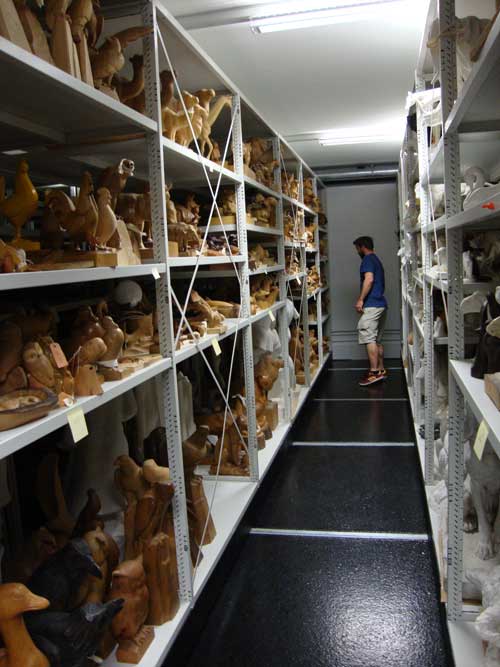
In the hands-on sessions, the students copy a variety of carved items and styles – the school’s archives contain numerous examples – and also study animal and human skeleton models to understand musculature. “You have to understand what these muscles do for the figure to make sense,” René said. “If you know what the muscle is supposed to do in the body, you authentically put it in the right way.” 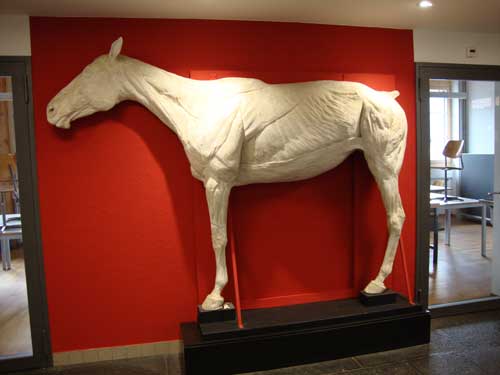 They also do sketches, and carve in modeling clay for practice. At first, René said, they need to observe a shape and copy it. Later, it’s “observe, sketch, make it in clay, then carve it in wood yourself.” The most important skill she’s learned in the school, Lucy said, is to “be a good observer. What is difficult is if you just have a model in front of you and you have to copy this. You learn to see and put an eye on all the details, to have a good look at it.”
They also do sketches, and carve in modeling clay for practice. At first, René said, they need to observe a shape and copy it. Later, it’s “observe, sketch, make it in clay, then carve it in wood yourself.” The most important skill she’s learned in the school, Lucy said, is to “be a good observer. What is difficult is if you just have a model in front of you and you have to copy this. You learn to see and put an eye on all the details, to have a good look at it.”
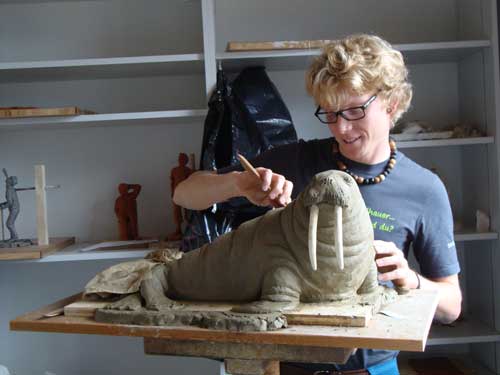
The wood the students are carving on is mostly linden (aka basswood), but René, who procures the wood for the school says “Sometimes I buy milled lumber; sometimes I buy whole trees; sometimes I cut the trees myself and bring them here. If just for a change, I’ll bring plum and apple and pear, all the fruit trees – except for cherry; we don’t like it as well. With walnut, it’s possible to get a full figure carved into it without ending up with any cracks. That’s hard with cherry.”
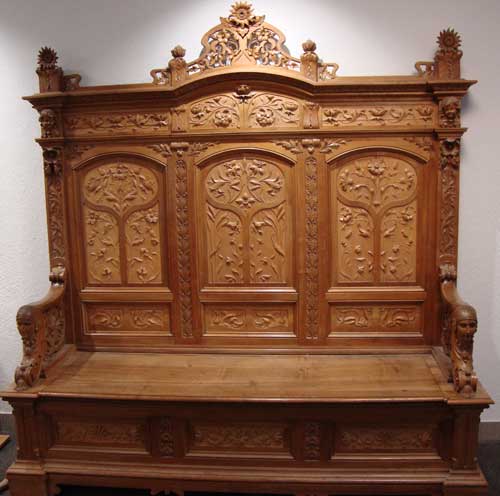
The students also learn to create various textures — one of the practical tests in her final exams, Lucy said, would be to add texture to a basic shape of an animal in a four-hour time period. Some of their lessons, René said, include taking 30 to 35 flat workpieces and carving different shapes into the boards. Half of the shapes are done with the grain, and half against it; “They get a feel for wood as the material. Every project is set up in a certain way, and they have to cut it with a different type of chisel,” he said. When a student starts at the school, he or she buys 100 chisels, at a cost of about 1,000 Swiss francs (roughly equivalent to $1,000 U.S. dollars at current exchange rates). They learn how to use, and to sharpen, them all. “When they go home, they’ll maybe have 125 chisels,” René said – and are likely to use them for years.
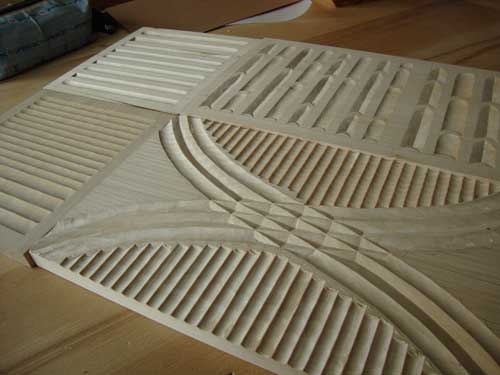
On the other hand, attending the school, for the students who are accepted, is free. “It’s all paid by the government,” René said. “That’s something I learned to appreciate when I was living abroad. It’s the same with university. Whether you want to be a doctor, or dentist, or landscaper, or whatever it is, the government’s always covering the cost. Whether you’re from a poor family or a rich family, you can do the job you were meant to do.” 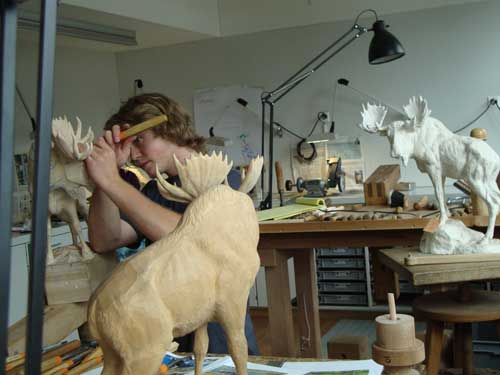 Students do need to find their own accommodations. Many of them share apartments in the town of Brienz, or rent rooms from local residents. Some of the students receive support from their home provinces, and some work during hours they are out of school. They might also get a percentage if they work on projects the school has been commissioned for – like redoing old seats from the country’s parliament building. “They phoned 100 carvers to help, but most were too busy, and could only come for a day or two,” René said. Still, it’s not as easy as it used to be to find a job as a full-time woodcarver after graduation. The origins of Brienz’s status as a woodcarving region come from the era of the first tourists coming to see the Alps. The local farmers rowed these tourists across the water in the summer, and when winter came, “they started to carve a little cow or something as a giveaway, as souvenirs. Then they noticed good money in it, and it became really trendy,” René said.
Students do need to find their own accommodations. Many of them share apartments in the town of Brienz, or rent rooms from local residents. Some of the students receive support from their home provinces, and some work during hours they are out of school. They might also get a percentage if they work on projects the school has been commissioned for – like redoing old seats from the country’s parliament building. “They phoned 100 carvers to help, but most were too busy, and could only come for a day or two,” René said. Still, it’s not as easy as it used to be to find a job as a full-time woodcarver after graduation. The origins of Brienz’s status as a woodcarving region come from the era of the first tourists coming to see the Alps. The local farmers rowed these tourists across the water in the summer, and when winter came, “they started to carve a little cow or something as a giveaway, as souvenirs. Then they noticed good money in it, and it became really trendy,” René said.
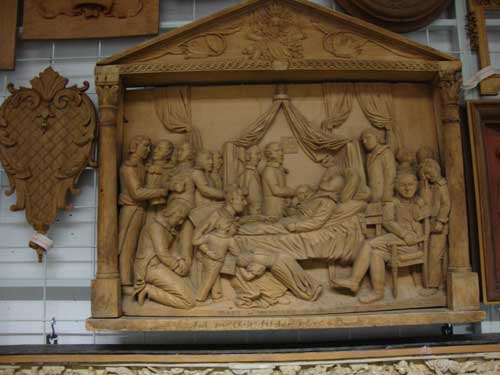
At one point, you might have someone who carved bears, someone who carved ibexes, someone who carved flowers; and the government, which had to support the farmers in this area of rocky landscapes, saw an opportunity and began sending local woodcarvers to French academies so they could learn better techniques and come back and teach others. In times past, hundreds of area woodcarvers earned their living with the craft. “In the glory days, probably anyone who could carve anything that looked remotely like a cow, he could probably sell it,” René said.
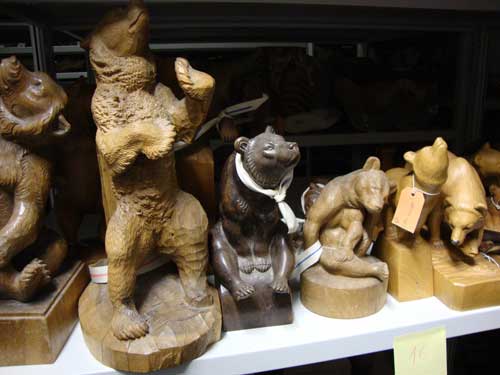
Nowadays, however, the market is going down. And the woodcarving school’s students, who develop their own preferred style in the later years of schooling, don’t always find that it matches market demands. Lucy’s favorite pieces to make, for example, are “copies of things that are not made [originally] of wood, but of another material” – like carved toothpaste tubes, for instance. “That tends more to the art side than what people would buy. More traditional things are more in demand around here.” One day, she’d like to open her own studio, but for now, following her graduation this summer, she’s just looking for a job related to woodworking.
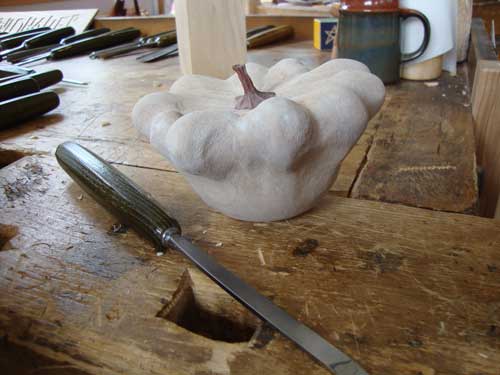
“The ones who really have the passion for it, they get work,” René said. Sometimes, their lessons in shaping lead them to such tasks as creating fancy ice sculptures at hotels in St. Moritz, he said, citing one example. “With all the things they learn here, they can do a lot, even if sometimes they have to step off the beaten path.”







